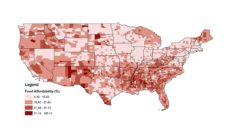One in six children in the United States (13 million) live in food-insecure households. Food insecurity, defined as having limited or uncertain access to enough food, is a major public health challenge. Children who experience food insecurity experience high rates of malnutrition, developmental and learning impairments, and mental health and behavior problems.
Food insecurity includes both not having enough food of any type and also not having enough healthy, nutritious food. Food insecurity includes worrying about having too little food. Food insecurity exists on a continuum of severity, with families categorized as either food secure or food insecure. Food insecurity can lead to skipping meals and experiencing hunger. The worse food insecurity is, the worse health and behavior outcomes.
I recently published a study with my colleague, Anika Schenck-Fontaine, showing that food insecurity varies from day to day. We used text messages to survey 105 parents with young children every day for a month. The survey asked parents three questions about access to food: 1) Are you worried that they would run out of money to buy food? 2) Have you eaten less today because you don’t have enough money for food? 3) Do you feel unable to afford balanced meals? Every parent enrolled was receiving Supplemental Nutrition Assistance Benefits (SNAP; formerly known as Food Stamps).
Our finding that food insecurity increases substantially in the second half of the SNAP month adds to the growing understanding that SNAP benefits are inadequate for many families.
We found that some days parents feel more worried about their ability to access food than on other days. Parents reported feeling worried about running out of money to buy food on 22% of days in the month (nearly one week per month). They also reported eating less because they had less on 21% of days in the month and feeling unable to afford balanced meals somewhat or a lot on 31% of days (almost 1.5 weeks per month).
Although SNAP is a crucial part of the social safety net, many researchers have found that benefits are not sufficient to support families for the entire month. Our study shows that families run out of money at the end of the SNAP month. As a result, they experience more food insecurity at the end of the SNAP month. Among those who were already experiencing food insecurity at the beginning of the SNAP month, their worry became more severe as the days passed. For example, parents were asked, “How much did you feel today that you couldn’t afford to eat balanced meals?” Answer choices were: “a lot;” “somewhat;” or “not at all.” On most days parents answered “somewhat” or “not at all.” By the end of the SNAP month, a substantial shift occurred, with over 20% of parents answering “a lot.”
Our finding that food insecurity increases substantially in the second half of the SNAP month adds to the growing understanding that SNAP benefits are inadequate for many families. Our results suggest that increasing benefit amounts or making SNAP disbursements more frequent would increase food security in households with young children.
Photo by Morgan Vander Hart on Unsplash














